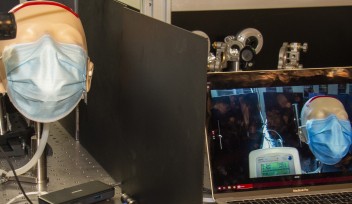Modeling the Spread of COVID-19

A team from OIST, led by Professor Simone Pigolotti and postdoctoral researchers, Dr. Deepak Bhat, Dr. Davide Chiuchiù and Dr. Paula Villa Martín from the Biological Complexity Unit have developed two mathematical models to predict the spread and impact of COVID-19 within the Okinawa Prefecture.
The working document, with full preliminary modeling methods and results, will soon be released on the preprint server, medRxiv.
The group developed these models based on established models created by other groups around the world for tracking the spread of the epidemic. The scientists adapted the models for the case of Okinawa, incorporating information on the number of daily cases, the rate of hospitalization, the estimated number of infected people arriving at Naha airport, the age distribution of Okinawa and the number of intensive care unit beds available.
“The data we gathered showed that the number of cases of COVID-19 in Okinawa during April has grown exponentially, with cases doubling roughly every five days,” said Prof. Pigolotti. “From the rate of hospitalization, our model estimated that by mid-April, there might have been thousands of people in Okinawa been infected with COVID-19.”
This finding is supported by preliminary data in other areas of the world, where antibody testing suggests that the number of real cases may be between 28 to 55 times higher than the number of confirmed cases.
The scientists used the models to predict the total number of cases, deaths and burden on intensive care unit beds under different containment scenarios: no containment, stringent containment and weaker containment. The models also explored the effect of delayed containment on the spread of COVID-19.
The results highlight the importance of immediate and stringent containment measures in Okinawa to reduce the numbers of cases and deaths.
When using a baseline scenario of no containment, the scientists estimated a reproductive number – a mathematical term describing how contagious an infection is – of 2.5. This means that for every infected person, it is expected to spread to an average of 2.5 other individuals.
Under this condition, the models predicted a large fraction of the Okinawan population would contract COVID-19, with a peak occurring roughly at the end of May, at which point roughly 5000 intensive care unit beds would be required. The models also predicted around 20,000 deaths by the end of 2020.
“These results are based on a hypothetical, worst-case scenario,” said Prof. Pigolotti. “In reality, some containment measures have already been implemented, such as the closing of schools, the suspension of some public events and more stringent airport controls, which all contribute to lowering the reproductive number.”
The scientists then explored two hypothetical containment scenarios, one where stringent containment measures reduced the reproductive number by 65%, to slightly lower than one, meaning that each infected person on average spreads the infection to fewer than one other person, and a second scenario where weaker containment measures only reduced the reproductive number by 40%, to around 1.5.
The models showed that in the first scenario with stringent containment, the death count is reduced to 1000, with 170 intensive care unit beds required at the infection peak. In contrast, using the second scenario with weaker containment, the models predicted a high death count of about 14,000 deaths by the end of the epidemic, with 2,700 intensive care unit beds required at the infection peak.
“This emphasizes how crucial it is to suppress the reproductive number to less than one, through stringent containment measures, in order to halt the spread of COVID-19,” said Prof. Pigolotti. “It is also important to note that reducing the reproductive number to just less than one is not the best-case scenario; if containment measures in Okinawa are effective enough to reduce the reproductive number by more than 65%, then the death count will be further reduced.”
The scientists also assessed the impact of delayed containment measures of the spread of COVID-19. They found that a 12-day delay of stringent containment measures up to May 1st resulted in the models predicting about 4000 deaths, with around 800 intensive care unit beds required capacity at the peak.
“One goal from this research was to understand how the situation in Okinawa is unfolding, but the most important outcome will be as an aid to policy-making,” said Prof. Pigolotti. “By using models to estimate the potential impact of COVID-19, this allows officials to make more informed decisions about when and how to respond.”
Simultaneously to the completion of this research, the Okinawa Governor Denny Tamaki made an Emergency Declaration in response to COVID-19 introducing more stringent measures. He has urged the public to reduce contact with others by only leaving the house when necessary and refraining from non-essential travel. He has also instructed the public to protect themselves by thorough hand washing and wearing masks.
Specialties
Research Unit
For press enquiries:
Press Inquiry Form













